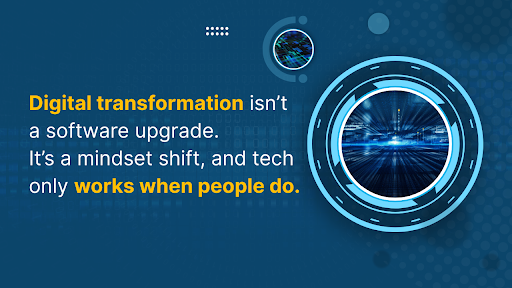
If you ask companies about their digital transformation journey, most of them will start listing tools: a new ERP, an AI-based analytics system, a cloud migration. But here is the uncomfortable truth, technology alone rarely transforms anything.
I have seen organisations spend millions on platforms that never get fully used, dashboards that no one trusts, and automation that ends up creating more work instead of reducing it. The problem isn’t the technology. It’s the mindset behind it.
1. Transformation Begins Between People, Not Platforms
Digital transformation is less about what you implement and more about how your teams think, operate, and make decisions. Before any tool can add value, the organisation must build the culture and behaviours that allow it to work.
That means shifting mindsets from:
- “This is how we have always done it” to “What’s the best way to do it now?”
- “Tech is an IT project” to “Tech is a business enabler.”
- “Change is risky” to “Standing still is riskier.”
Without this cultural foundation, even the best technology will meet resistance. Teams will revert to old ways, data will be underused, and workflows will stay broken.
2. Redesign the Workflow Before You Digitise It
One of the most common mistakes I see is automating existing processes as they are. If those processes are inefficient or poorly designed, technology will only make the inefficiency run faster.
True transformation starts with rethinking workflows:
- What steps are adding no value?
- Where are decisions getting delayed?
- How can teams collaborate better?
Once the process is reimagined, then technology becomes a force multiplier, enabling speed, accuracy, and visibility across the organisation.
3. Overcome Resistance by Aligning Stakeholders Early
Change is rarely rejected because people dislike technology. It’s rejected because people feel unseen or unprepared. The key is to involve stakeholders from the start and not after decisions are made.
Bring frontline teams into the design phase. Help leaders understand the “why” behind the transformation, not just the “what.” Train people to use new systems confidently. When people feel part of the process, adoption becomes a shared mission, not a top-down mandate.
4. A Roadmap for Mindset-Led Transformation
If you are leading digital change, here is a simple roadmap that works:
- Assess culture and readiness. Understand the current mindset, pain points, and openness to change.
- Redesign workflows. Fix inefficiencies before introducing technology.
- Align leadership and teams. Communicate vision, purpose, and expected outcomes clearly.
- Introduce tech in phases. Start small, show value, and scale with confidence.
- Build continuous learning. Transformation is ongoing; so invest in upskilling and adaptation.
Conclusion
Digital transformation is not a project with a finish line. It’s a capability, one that allows your organisation to adapt faster, make data-driven decisions, and stay future-ready. But that capability doesn’t come from software. It comes from people who are willing to think differently, challenge assumptions, and embrace new ways of working.
When mindset leads and technology follows, transformation stops being a buzzword and starts becoming a business advantage.
#DigitalTransformation #Leadership #BusinessStrategy #ChangeManagement #FutureOfWork


